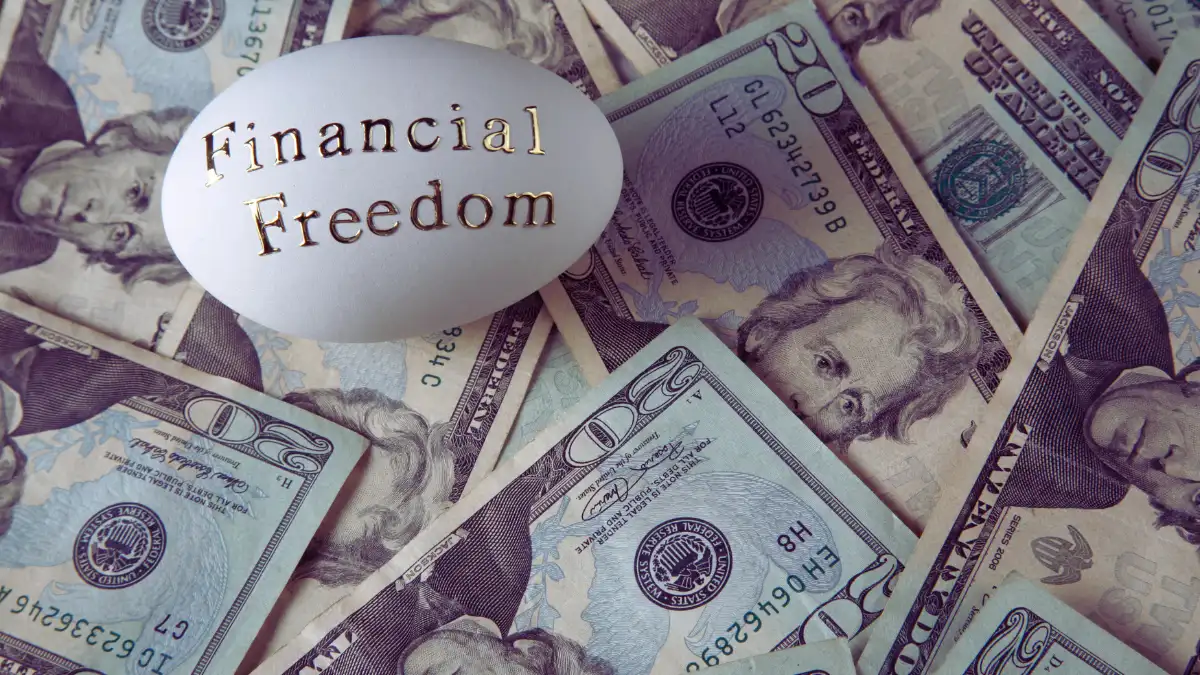You make decent money. You pay your bills on time. You have health insurance and a retirement account.
So why does it feel like you’re stuck on a treadmill that never stops?
Here’s the brutal truth: 65% of middle-class Americans say they’re struggling financially and don’t expect things to get better for the rest of their lives. You’re caught in the middle-class trap. You earn too much to get help. You earn too little to build real wealth.
Let’s fix that.
Why Making $75,000 Feels Like Making $40,000

You got a raise last year. Great, right?
Wrong.
In 2024, inflation ran at 3-4% while middle-income wages only grew by 2%. You’re actually losing money every year. Your paycheck grows. But your buying power shrinks.
Think about what you could afford five years ago. Now compare that to today. Gas costs more. Groceries cost more. Rent costs more. Everything costs more.
Americans now say they need $186,000 per year just to feel financially secure. That’s more than double what most middle-class families make.
Here’s what happened. You used to spend $200 at the grocery store and leave with full bags. Now you spend $300 and barely fill your cart. Your rent was $1,200. Now it’s $1,800. Your car insurance doubled.
But your boss gave you a 3% raise and acted like they were being generous.
The middle class is slowly getting crushed. And most people don’t even realize it’s happening.
The Real Numbers: What “Middle Class” Actually Means in 2025

Let’s talk about who’s actually middle class.
In 2025, middle-class income nationally ranges from $49,500 to $148,500 per year. But that changes based on where you live. In Massachusetts, you need $66,565 to $199,716 to be middle-class. In Mississippi, it’s $36,132 to $108,406.
According to the Pew Research Center’s 2023 report “The State of the American Middle Class,” only 51% of U.S. adults lived in middle-income households in 2022. From 1971 to 2023, the share of Americans in the middle class shrank while both the lower-income and upper-income groups grew.
But here’s the problem with these numbers. They only look at income.
When you measure the middle class by actual financial security—having emergency savings, being able to retire comfortably, affording a $1,000 emergency without debt—only 35% of Americans qualify.
You might have a middle-class income. But do you have middle-class stability? Probably not.
The top 10% of households hold 67.2% of all wealth in America, averaging $8.1 million each. The bottom 50% hold just 2.5% of wealth, averaging $60,000 each.
The gap isn’t just big. It’s massive. And it’s growing every year.
Trap#1: The Golden Handcuffs of “Good Enough” Income

Your parents told you to get a good job. Work hard. Save money. Retire at 65.
That advice doesn’t work anymore.
In 1985, a typical male worker could support a family of four with healthcare, housing, transportation, food, and college savings on just 40 weeks of income. Today it takes 62 weeks.
Wait. There are only 52 weeks in a year.
Exactly.
Your “stable job” keeps you stuck because it gives you just enough money to survive. Not enough to build wealth. Not enough to take risks. Not enough to invest in things that could set you free.
You can’t quit because you need health insurance. You can’t start a business because you need a steady income. You can’t take a lower-paying job you’d love because you have bills to pay.
This is the golden handcuffs. Your job keeps you comfortable enough that you’re scared to leave. But it doesn’t pay enough to actually get ahead.
80% of Americans have lived paycheck to paycheck at some point. When you’re living paycheck to paycheck, you can’t build wealth. You’re too busy surviving.
Trap# 2: Lifestyle Inflation Is Killing Your Future

Remember your first apartment? You were happy with cheap furniture and a small TV.
Now look at your life. Bigger apartment. Nicer car. Better phone. Streaming services. Gym membership. Regular takeout.
Every time you got a raise, your expenses grew to match.
This is lifestyle inflation. It’s silent. It’s deadly. And it’s keeping you poor.
You make $75,000 now instead of $50,000. Great. But somehow you’re not saving any more money than you did five years ago. Why? Because you upgraded everything.
In Florida, median home prices exceed $400,000, and rental prices average $2,500 per month. Housing alone can eat half your paycheck.
Then add your car payment. Student loans. Credit cards. Phone bill. Internet. Subscriptions. Insurance. Food. Gas.
You’re making more money than your parents did at your age. But you feel broke.
The problem isn’t your income. It’s that your spending grew faster than your paycheck.
Rich people do the opposite. When they make more money, they keep living like they did before. They invest the difference.
Trap#3: The Debt Trap Starts With “Good” Decisions

You took out student loans to get a good job. That’s responsible, right?
You bought a reliable car so you can get to work. Makes sense.
You keep a credit card for emergencies. Smart planning.
But now you’re drowning.
Americans owe $1.209 trillion in credit card debt. The average household carries $6,371 in credit card balances.
In the first quarter of 2025, student loan delinquencies spiked to 8.04%, up from less than 0.80% the previous quarter. For borrowers with credit scores above 720, the average credit score dropped 177 points when their student loan delinquency was reported.
Think about that. One missed student loan payment can destroy your credit score. Now you can’t get a mortgage. Can’t get a good car loan. Can’t even get approved for a decent credit card.
According to Federal Reserve Bank of Chicago research on middle-class households, higher monthly debt payments and interest rates above 15% on credit cards are associated with a 15% decrease in the likelihood that middle-class households can save for major expenses like education and homeownership.
Every month, Americans spend about 11.2% of their income just on debt payments. That’s money you could be investing. Building wealth. Creating freedom.
Instead, it’s going to banks.
The trap works like this: You need debt to afford the “normal” middle-class life. But the debt prevents you from building wealth. So you stay middle class forever.
Trap#4: You Can’t Save Because You’re Always Catching Up

Let’s talk about emergency savings.
You know you should have 3-6 months of expenses saved. Everyone says so.
But only 54% of Americans have enough emergency savings to cover three months of expenses.
52% of Americans say paying for an unexpected expense causes them significant stress. 49% can’t save for unexpected expenses at all.
Why? Because you’re always catching up.
The car needs new tires. That’s $600. The AC breaks in the summer. That’s $1,200. Your kid needs glasses. The dog needs surgery. Your computer dies.
In the past year, 37% of Americans needed to use their emergency savings. 80% of those people used it for essentials—actual emergencies, monthly bills, or day-to-day expenses.
You try to save. You really do. You put $500 in savings. Then something breaks, and you take out $400. You build it back up to $300. Then another emergency hits.
You’re running in place.
73% of Americans are saving less for emergencies due to inflation, elevated interest rates, or changes in income. That’s up from 68% just a year ago.
Without savings, you can’t invest. Without investing, you can’t build wealth. Without wealth, you stay trapped.
Trap#5: Your 401(k) won’t Set You Free

Your employer matches 3% of your 401(k). You contribute 6%. You’re doing everything right.
But you won’t be able to retire.
Only 21% of middle-class Americans are very confident they can fully retire or maintain a comfortable lifestyle throughout retirement.
49% of people who aren’t retired yet expect to work beyond the traditional retirement age. 34% expect to retire after age 65—if they can retire at all.
Your 401(k) is better than nothing. But it’s not enough.
Let’s do the math. You make $70,000. You save 10% ($7,000 per year). Your employer adds 3% ($2,100). That’s $9,100 per year.
Over 30 years, with 7% returns, you’ll have about $870,000.
Sounds good, right? But inflation will eat half of that buying power. You’ll really have the equivalent of $435,000 in today’s money.
Can you live on that for 20-30 years? Probably not comfortably.
The top retirement fears among middle-class Americans are outliving their savings (40%), declining health that requires long-term care (40%), and Social Security getting reduced or eliminated (39%).
The 401(k) system assumes you’ll work for 40 years, retire at 65, and die at 85. But what if you want to stop working at 50? Or 45? Or 40?
Traditional retirement planning keeps you working your whole life. That’s not freedom.
What Financial Freedom Actually Looks Like (And Why You Don’t Have It)

Let’s define freedom.
Financial freedom means your investments make enough money to cover your living expenses. You don’t need a job. You work because you want to, not because you have to.
This is called the FIRE movement—Financial Independence, Retire Early.
The basic rule: You need 25 times your annual expenses saved and invested. Then you can withdraw 4% per year and never run out of money.
Here’s what that looks like:
- You spend $40,000 per year: You need $1 million
- You spend $50,000 per year: You need $1.25 million
- You spend $60,000 per year: You need $1.5 million
Traditional FIRE requires $1-2 million, depending on your lifestyle. Lean FIRE (minimalist lifestyle) needs $500,000-$750,000. Fat FIRE (luxury lifestyle) requires $2.5 million or more.
Most middle-class families are nowhere close to these numbers. If all middle-class wealth were divided equally, each household would have about $481,000. That’s not enough for financial freedom.
You’re comfortable. You can pay your bills. But you’re not free. You still need that paycheck every two weeks.
That’s the trap.
The Math That Shows Why Traditional Advice Fails

Let’s see why doing what your parents told you doesn’t work.
Traditional advice says save 10-15% of your income. So let’s say you save 10%.
At a 10% savings rate, it requires nine years of work to accumulate enough to cover one year of living expenses. Increasing the savings rate to 25% shortens this period to just three years of work for one year of expenses.
Meanwhile, saving half of one’s income means only a single year of work is needed to save for an entire year’s cost of living.
See the difference?
Saving 10% means you’ll work for 40+ years before you can retire. Saving 50% means you could retire in 15-17 years.
Let’s use real numbers. You make $70,000 per year after taxes.
Traditional path (10% savings):
- Save: $7,000 per year
- Spend: $63,000 per year
- Need for freedom: $1,575,000 (25 × $63,000)
- Time to reach goal: About 45 years
Aggressive path (50% savings):
- Save: $35,000 per year
- Spend: $35,000 per year
- Need for freedom: $875,000 (25 × $35,000)
- Time to reach goal: About 17 years
Same income. But one person retires at 67. The other retires at 42.
The difference? How much do you save? How much do you spend? Nothing else.
This is why traditional advice keeps you trapped. It sounds reasonable. But the math doesn’t work.
Strategy#1: How to Cut Expenses Without Feeling Poor

You can’t save 50% of your income if you’re already spending 100% of it.
So let’s cut expenses. But we’re not talking about skipping lattes. That’s stupid advice that saves $100 per year.
We’re talking about big cuts that save $10,000 or more per year.
Housing: This is probably 30-40% of your budget. Can you get a roommate? Move to a cheaper area? Rent out a room on Airbnb? Downsize?
Cars: Most people have car payments of $400-700 per month. Buy a used car with cash. Drive it for 10 years. Save $60,000.
Food: Eating out costs 3-4 times more than cooking. Cut restaurant meals from 10 times per month to 2 times. Save $400 per month.
Subscriptions: Netflix, Hulu, Spotify, gym, software, and Amazon Prime. Add it all up. You’re probably spending $200+ per month. Cut half of them. Save $1,200 per year.
Insurance: Call your insurance companies. Ask for discounts. Bundle policies. Raise deductibles. Save $500-1,000 per year.
Track every dollar you spend for 30 days. You’ll be shocked. Most people find $500-1,000 per month in waste.
Cut the waste. Keep what brings you joy. This isn’t about being cheap. It’s about being intentional.
Ask yourself: Does this expense bring me closer to freedom? Or does it keep me trapped?
Strategy#2: Build Income That Works While You Sleep

You can’t cut expenses forever. Eventually, you need to make more money.
But not by working more hours at your job. That’s still trading time for money.
You need passive income. Money that comes in whether you work or not.
Here are ways to start:
Dividend stocks: Companies like Ford, Verizon, and Walgreens pay regular dividends to shareholders. Buy dividend stocks and get paid every quarter.
REITs: Real Estate Investment Trusts let you invest in real estate for as little as $10. They’re required to pay out 90% of their income to shareholders. The Dow Jones Equity All REIT Index returned 11.3% in 2023.
High-yield savings: Some banks offer 4%+ interest on savings accounts. Put $10,000 in and earn $400 per year doing nothing.
Rental property: Landlords in the U.S. reported average annual income of $87,280 in 2025, though this varies by property and location. You can start small—rent out a room in your house.
Online business: Create a course. Write an ebook. Start a YouTube channel. Build something once. Sell it forever.
Most successful creators earn $1,000-$5,000 monthly once established. That won’t make you rich overnight. But $2,000 per month in passive income changes everything.
Start with one. Master it. Then add another. The goal is to replace your job income with passive income.
Strategy#3: Invest Like You Want to Quit Your Job Someday

Most people invest wrong. They’re too conservative. They keep money in savings accounts earning 0.5%. Or they try to pick winning stocks and lose money.
Here’s the right way:
Put 70-80% in low-cost stock index funds (like the S&P 500). Put 20-30% in bonds. Rebalance once per year. That’s it.
Why index funds? Because they own a piece of hundreds of companies. When the market goes up, you win. And over time, the market always goes up.
The S&P 500 has returned about 10% per year for the last 50 years. Not every year. But on average.
Let’s say you invest $1,000 per month ($12,000 per year) with 10% returns:
- After 10 years: $206,000
- After 15 years: $418,000
- After 20 years: $760,000
- After 25 years: $1.3 million
That’s how normal people become millionaires.
Open an account with Vanguard, Fidelity, or Schwab. Buy VTI or VOO (S&P 500 index funds). Set up automatic investments. Don’t touch it for 20 years.
This isn’t exciting. But it works.
Strategy#4: Kill Your Debt Before It Kills Your Dreams

You can’t build wealth while drowning in debt.
33% of Americans have more credit card debt than emergency savings. If that’s you, fix it now.
Here’s the plan:
Step 1: List every debt. Write down the amount owed, interest rate, and minimum payment.
Step 2: Pay minimums on everything except one debt.
Step 3: Attack the highest interest rate debt with every extra dollar you have.
Step 4: When that debt is gone, move to the next highest interest rate.
This is called the avalanche method. It saves you the most money on interest.
Or use the snowball method: Pay off the smallest debt first for quick wins. Less efficient, but better psychology.
Either way, get rid of high-interest debt fast. Credit card debt at 20% interest is an emergency.
Can you get a balance transfer card with 0% interest for 18 months? Do it. That gives you 18 months to pay it off without new interest.
Can you consolidate loans at a lower rate? Do it.
Can you negotiate with creditors? Try it. Sometimes they’ll settle for less than you owe.
The goal: Become debt-free except for your mortgage. Then you can invest aggressively.
Strategy #5: Create Your Financial Freedom Timeline

Here’s exactly what to do:
Month 1: Track and Calculate
- Track every dollar you spend for 30 days
- Calculate your current savings rate
- Calculate your freedom number (annual expenses × 25)
- Figure out the gap between where you are and where you need to be
Month 2: Cut and Optimize
- Cut expenses by 20-30%
- Call insurance companies for better rates
- Cancel subscriptions you don’t use
- Increase your savings rate to at least 20%
Month 3: Eliminate Debt
- Make a debt payoff plan
- Attack highest highest-interest debt first
- Find extra money to throw at debt
- Stop taking on new debt
Month 4: Start Investing
- Open a brokerage account
- Set up automatic investments
- Start with index funds
- Don’t check it obsessively
Month 5-6: Build Income
- Research passive income options
- Pick one that fits your skills
- Start small
- Test and learn
Every month after:
- Increase savings rate by 1% per month until you hit 50%
- Continue debt payoff plan
- Grow passive income streams
- Track net worth monthly
At a 50% savings rate, you can reach financial independence in about 17 years. Start at 30 and you’re free at 47. Start at 40 and you’re free at 57.
Still better than working until you’re 67.
What Happens When You Actually Do This

Let’s be honest. This is hard.
You’ll feel broke at first. Your friends will think you’re weird. You’ll watch them buy new cars while you drive an old one. They’ll go on fancy vacations while you stay home.
But here’s what else happens:
Your debt disappears. Your savings grow. Your investments compound. You start seeing progress.
Then one day, you realize you have 6 months of expenses saved. Then a year. Then you hit $100,000 in investments. Then $250,000.
Your passive income starts paying for your groceries. Then your rent. Then all your bills.
You realize you could quit your job if you wanted to. You don’t have to. But you could.
That’s freedom.
Remember: 65% of middle-class Americans don’t expect their financial situation to improve. They’re resigned to struggling forever.
Don’t be them.
You can stay comfortable and trapped. Or you can be temporarily uncomfortable and become free.
The middle-class trap is real. But it’s not permanent.
You just have to want freedom more than you want comfort.
Most people aren’t willing to make the trade. Most people will work until they’re 67 and hope they saved enough.
But you’re still reading. Which means you’re different.
Calculate your freedom number today. Track your expenses this month. Pick one passive income stream to research this week.
Your future free self will thank you.
The trap only holds people who don’t know it exists. Now you know. What are you going to do about it?






